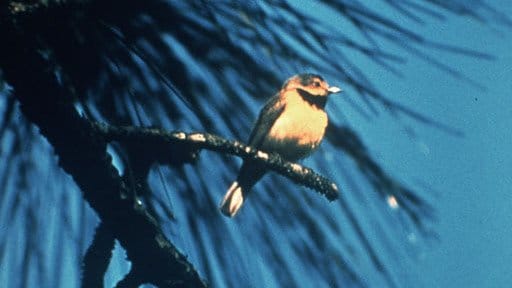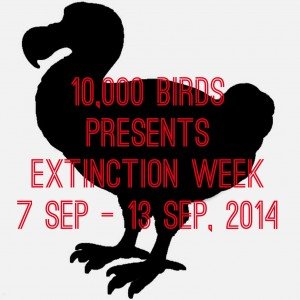
Rightly or wrongly, there’s an hierarchy of extinct birds in North America, in the United States in particular. Each offers a portrait of a nation at a crossroads, a series of Aesop’s Fables – most well-known by anyone with an interest in birds or nature – for a nascent environmental movement whose themes become more or less relevant in the public mindset depending on what issues need to be addressed. There’s the one about the pigeon that represents a young nation’s disgraceful squandering of its seemingly unlimited resources. The one about the parakeet that represents the loss, before we even knew it, of an element of our wild places that seems so outlandishly foreign as to be unimaginable now. The one about the woodpecker that represents a glimmer of hope that we didn’t really screw it all up after all, however desperately faint that glimmer is anymore.
But there are others too, farther down on the list and mostly forgotten. A weird mussel-eating duck. A slight, transhemispheric curlew. And a warbler from the Southeast United States who came on the scene and left again so rapidly that it’s near to unknown in the ornithological record.
The species is said to have never been common, a description I’ve always thought is applied too liberally to long-gone species almost as a convenient declaration of helplessness or shrug of the shoulders toss off in the face of its eventual demise. What could we have done? After all, it was never common. But it was present, and in a place and time that suggested that it would always be so if in small numbers. Certainly warblers have faced long odds before. Why is this one different?
Bachman’s Warbler was named for the renowned southern naturalist, Rev. John Bachman. Bachman’s story is fascinating in itself. As a social reformer in antebellum Charleston, South Carolina, his influence in human rights circles – he insisted on educating African slaves and had an integrated congregation in Charleston, the cruel heart of the slave industry, before the American Civil War – loomed as large as his influence in the local natural history scene, which was significant. He discovered the little black-bibbed warbler in 1832 in the canebrakes of coastal South Carolina on one of his frequent outings, collected it, and sent the skins on to John James Audubon who eventually named the species he would never see after his friend.

Photo by Jerry Payne, Charleston Co, SC, 1958
The species disappeared from the record for several decades afterwards due to the war and all, but it popped up again in the mid-1880’s where it was reported to occur in decent numbers across much of the southeast all the way west to the Mississippi bottomlands of southeast Missouri’s bootheel. Apparently, wherever there was slightly open forest with a dense understory of Giant Cane, Bachman’s was found. But in the early 20th century industry came even to the sleepy south and the pine forests that stretched unbroken were felled to feed the fires of industry as too often is the way of things. Up until 1930, Bachman’s were regular. After that, they became significantly less so.
Things were not going too well in their wintering range either. It’s not known for sure whether the entirety of the population of the species always wintered on the island of Cuba but by the time people cared enough to find out that’s where they were going. As is the case when any vulnerable species is concentrated in one critically important part of the world, this is not a positive development for its well-being. A series of incredibly destructive fall hurricanes in the early 1930s likely took a heavy toll.
By about 1940, reports began to come saddled with the depressing qualification “last certain”. From Cuba in 1940. In Missouri in 1948. Mississippi in 1949. Florida in 1951. A few persisted in Rev. Bachman’s Charleston into the 60s when a solitary male in 1962 sang for no one but a group of incredibly fortunate birders.
Dribs and drabs through the 80s. Nothing but ghosts since.
What does it mean for any of us that the Bachman’s Warbler is gone? Sadly, probably not a lot. North America certainly doesn’t want for wood-warblers, many of whom are more dramatic that the little canebrake dweller. But there’s light in this darkness in that we might justifiably point to the relative success of the equally habitat obligated Kirtland’s Warbler as an example of how we’ve learned a thing or two about ecosystem management both here and abroad from the loss of the Bachman’s. So even though the Bachman’s Warbler probably sits near the bottom of that unfortunate hierarchy, its demise may have the most long-term significance.
And that’s a comforting bit of irony that anyone can appreciate.
…
This post originally appeared on 10,000 Birds on 10 May 2011 during Wood-Warbler Week.
…
Extinction is forever. A species, wiped off the earth, never to exist again. What a horror! What a disaster! What a wrong!
 It is correct, of course, to think of extinction this way during the Holocene Extinction, which we are living through right now. After all, the extinctions have occurred, are occurring, and will occur because of us, people. We have so altered the earth – pumping pollution, moving species around, destroying ecosystems – that many species, dependent upon ecological niches or simply unprepared for an onslaught of unfamiliar organisms with which they did not evolve, have no chance. It is depressing and angering and just wrong.
It is correct, of course, to think of extinction this way during the Holocene Extinction, which we are living through right now. After all, the extinctions have occurred, are occurring, and will occur because of us, people. We have so altered the earth – pumping pollution, moving species around, destroying ecosystems – that many species, dependent upon ecological niches or simply unprepared for an onslaught of unfamiliar organisms with which they did not evolve, have no chance. It is depressing and angering and just wrong.
But, in the wider view of things, extinction is necessary. It is what drives evolution. Extinction is what befalls the species that fails to adapt, to survive, to thrive. Most species go extinct. That is just the hard, cold reality of nature, red in tooth and claw.
This is not to say that we should sit back and let the Holocene Extinction continue. No! We must fight to save every species we can, every ecosystem, every niche.
It is the 100th anniversary of the extinction of the Passenger Pigeon, once one of the most abundant species in the world. In order to raise our awareness, to remind us of what we have lost, and to inspire us to fight for Every. Single. Species. we are hosting Extinction Week here on 10,000 Birds from 7 September to 13 September. Come back, click through, read, learn. And get angry and take action.
…













Leave a Comment